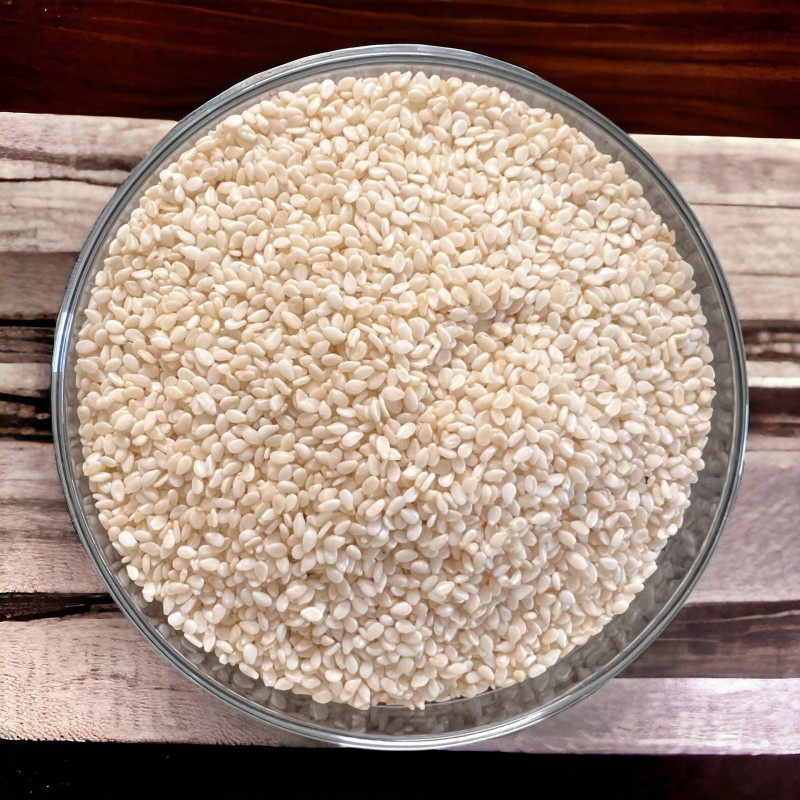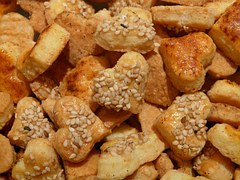
Reference: 12N7949601


It has a very pleasant taste with a slight nutty aroma.
It can be toasted or left raw. Excellent in salads, vegetables, meats, biscuits, on bread, or for coating fish cubes with an Asian flair.
 Delivery
Delivery
Mondial Relay
 Returns
Returns
See conditions
 Payments
Payments
100% secure
Delivered in a resealable bag
Also available in "golden". Click here!
Also available in "black". Click here!
 Small sesame seeds are widely used in cooking for their mild flavor, which resembles hazelnut, particularly when toasted. Heating enhances their taste significantly. To try this, simply dry-toast them in a pan for 2 minutes. They are excellent additions to salads, meat, or Asian-style sautéed vegetables.
Small sesame seeds are widely used in cooking for their mild flavor, which resembles hazelnut, particularly when toasted. Heating enhances their taste significantly. To try this, simply dry-toast them in a pan for 2 minutes. They are excellent additions to salads, meat, or Asian-style sautéed vegetables.
By mixing sesame seeds with salt and lightly grinding them, you can make the famous "gomasio", a well-known Japanese condiment! The usual proportion is 180g sesame to 20g salt. This mixture can be used on a variety of dishes, from vegetables to meats and fish, with the added benefit of reducing salt content. However, beware of its non-negligible calorie count!
They can also be used to coat fish cubes (instead of breadcrumbs), which are then fried in oil in the Asian style.
Grilled or ungrilled seeds can also be mixed into bread dough, often alongside other seeds like flax, or sprinkled on top, such as on hamburger buns.
Sesame seeds are also one of the three main ingredients of "za'atar", a Middle Eastern blend sprinkled on meatballs, vegetables, or mixed with oil to coat flatbreads before baking.
Raw seeds can also be consumed as sprouts.

Origin: India
Scientific name: Sesamum indicum
Common names: Benne, Benj
White sesame is used to make sesame paste (tahini or tahiné in Syria), produced by grinding seeds with a millstone (or blender), often with the addition of lemon and yogurt. By simply mixing whole seeds with salt, you can create a seasoning highly appreciated by vegetarians, "gomasio", used on raw vegetables and cereals.
Sesame seeds also produce an oil mainly used in Asian cuisine in China, Korea, and Japan, in salads, soups, and certain fondues. In Vietnam, they are used in soft nougats. This oil is notable for its resistance to rancidity.
 Unhulled seeds are particularly rich in calcium and phosphorus. They also contain significant amounts of other minerals, including magnesium, zinc, and iron, as well as plenty of fiber. Lastly, they are rich in vitamin E and antioxidants (lignans), as effective as those in flax seeds. When consumed daily, these lignans are believed to help lower "bad" cholesterol.
Unhulled seeds are particularly rich in calcium and phosphorus. They also contain significant amounts of other minerals, including magnesium, zinc, and iron, as well as plenty of fiber. Lastly, they are rich in vitamin E and antioxidants (lignans), as effective as those in flax seeds. When consumed daily, these lignans are believed to help lower "bad" cholesterol.
Sesame is an annual oilseed plant from the Pedaliaceae family, widely cultivated worldwide for its seeds. It can grow up to 1 meter tall, with lanceolate leaves about 10 cm long and 5 cm wide, decreasing in size as the stem grows. The tubular flowers are often yellow, followed by pods containing the seeds.
Its cultivation is expanding rapidly due to its ease and low production cost. White sesame is the most widely grown variety, traditionally used in Asia where the population is rapidly increasing, and its growing use in Europe for pastries and bakery products (especially hamburger buns).
Unlike many other food plants, sesame has undergone little modification by humans, retaining significant genetic diversity. As a result, plants vary in size and resistance to diseases and pests from region to region, or even from field to field. This offers researchers significant potential for genetic improvement of the plant.
Sesame is among the most common allergens, causing symptoms ranging from skin reactions to digestive or respiratory issues. Allergic individuals must strictly avoid consuming sesame or products containing it.
In India, sesame seeds are considered a symbol of immortality.
Nutritional Values per 100g:
°°°
The term "sesame" first appeared in 1298 and comes from the Greek "sesamon," borrowed from a language spoken in the eastern Mediterranean basin, likely meaning "fat" or "oil." Sesame is believed to be the first plant used to produce edible oil. Its cultivation dates back so far that its wild ancestor is no longer found.
Sesame's origin is uncertain, but it is thought to be African. It was consumed in India over 7,500 years ago, in China for at least 5,000 years, and traces were found in Mesopotamia as early as 2350 BC. Its popularity stems from its drought resistance, ease of oil extraction, and the oil's remarkable stability, which resists rancidity.
Sesame was introduced to America in the 17th century, carried by enslaved Africans during their tragic journey.
The name is mentioned in *The Thousand and One Nights* tales with Ali Baba's famous command: "Open sesame!"
***
Data sheet
Reference: 12N7949601
Reference: 00033669-0001
Reference: 9N76632004
Brand: Epiciane
Reference: 20701706
Reference: grainesaroussir
Reference: 124510
Reference: 12N7949601
Reference: 11N7754201
Reference: 9N76632004
Brand: Epiciane
Reference: 20711101
Reference: fenouilE
Reference: celerigraines
Reference: 11N7892701
Reference: 00033669-0001
Reference: 20703402
Reference: 10M6741201
Reference: coriandreE

It has a very pleasant taste with a slight nutty aroma.
It can be toasted or left raw. Excellent in salads, vegetables, meats, biscuits, on bread, or for coating fish cubes with an Asian flair.